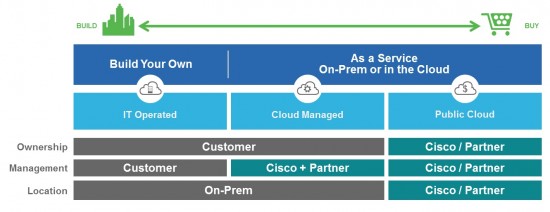Just as we are beginning to think that the latest cloud news may have become quite predictable, you run into an article that causes you to pause: “Dropbox moves 90% of its data off Amazon AWS in favor of its own private cloud”
What I found interesting about the article, as it relates to what I am about to discuss, is the fact that even if Dropbox spent two and a half years building its own private cloud ‘they have always had a hybrid cloud architecture’ in mind.
Cloud does involve technology, intimately. And with all the talk about public, private, and hybrid clouds; open-source versus commercial cloud management software; internally deployed versus hosted; it’s easy to get lost in the weeds. The question though is … ‘what’s your cloud strategy’? Unfortunately, today not many organizations have advanced cloud strategies in place and the reason is not necessarily poor planning.
Embracing cloud is all about retaining choice. This is true in general, simply because without choice you have no cloud strategy to begin with. The choices we make today will limit our decisions tomorrow. Choices set the context and define the strategy. And it all starts with the business strategy, which in turn shapes the context of your IT strategy. In this case, Dropbox retained business and IT flexibility by adopting a hybrid cloud architecture. This choice allowed them to make the decision to eventually take back 500 PB of data. This was a business decision as much as it was an IT decision.

N=2,378. Source: IDC InfoBrief, sponsored by Cisco, Don’t Get Left Behind:
The Business Benefits of Achieving Greater Cloud Adoption, Aug 2015.
Not surprisingly market research findings indicate that 64% of cloud adopters are using some form of hybrid cloud. I emphasize ‘some form’ of hybrid cloud, simply because the very same nature of what hybrid cloud is (or perceived to be) varies greatly among organizations.
Organizations that think strategically perceive cloud as an opportunity to shift the role of IT in the enterprise from focusing on more mundane, maintenance-oriented tasks to being catalysts for overall business innovation, digital disruption and ultimately revenue growth. Your cloud strategy needs to review the reasons why you’re considering cloud in the first place. Many cloud projects ‘fail’ simply because the goals, metrics and objectives were not clear to begin with.
Locking yourself into one vendor can mean ceding control over your ability to experiment and innovate. The best cloud strategy is the one that gives you the highest possible number of options— right up until the time you consume cloud services (and possibly beyond.) To that end, it is important to preserve choice in consumption models. Not all workloads are created equal. Are you targeting DevOps environments or traditional business-critical applications? Do you want to own the IT assets, or do you prefer usage-based pricing models? Do you want to outsource the management of your IT assets? Do you want to keep your data on premises? These and other choices have profound implications on your financial metrics, your internal organizational structure, your risk profile and the way you partner with your LoBs.

Cisco cloud deployment choices
The good news is that there are a variety of resources that can help you define your cloud strategy (e.g., identify choices) and successfully implement it (e.g., make decisions). Cisco continues to provide you with a number of choices to support your cloud projects. Additionally, Cisco and IDC have worked together to package the findings of multiple research studies into a set of tools that enable you to achieve greater impact as you execute your cloud strategy.
For example, with the Cisco Business Cloud Advisor framework (enabled by IDC) you can:
- Assess your organizational readiness for cloud adoption.
- Understand and quantify how improving your cloud strategy can benefit your business.
- Compare your cloud adoption levels with your peers by industry, company size or geography
- Identify gaps and opportunities (based on market data … versus anecdotal data points)
- Define a cloud adoption strategy and execution plan for better business outcomes.
So what’s your cloud strategy? Take a brief survey to begin the journey or contact us, you may be eligible to participate in a complimentary BCA Workshop.
Additional Resources:
Funny how your Intercloud fluff suddenly disappeared.
Hello Jerry –
A quick note, about the fact that this blog post is not about the Intercloud.
If you are a customer or a partner, I would like to hear more about any concerns you may have. You can reach me directly via email: efuiano@cisco.com – Thank you.”
Our cloud strategy is NOT to use Cisco. You guys DO NOT get cloud despite sponsored IDC reports. Looks like you guys forgot all the Intercloud BS you were spreading. A Nexus 9k does not a hybrid cloud make. Get real. You guys have become the laughing stock of the industry. Don’t lose your credibility further.
A quick note, about the fact that this blog post is not about Intercloud.
Nevertheless, Intercloud is a business model centered around helping our partners and customers leverage the benefits of connecting private, public, open, and hybrid clouds in a globally connected network of clouds. Partners are at the center of this strategy, and we are committed to working with them to deliver the cloud services that meet our growing customers’ needs.
We are excited about the road ahead. As our customers go through their cloud journey our recommendations regarding how to best accomplish their goals will continue to evolve (also based on our growing cloud portfolio.)
If you are a customer or a partner, and not a competitor, I would like to hear more about any concerns you may have. You can reach me directly via email efuiano@cisco.com – Thank you.”